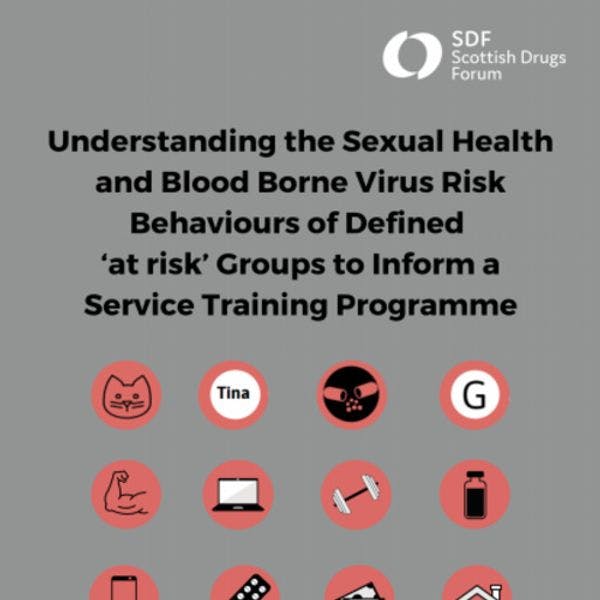Understanding the sexual health and blood borne virus risk behaviours of defined 'at risk' groups to inform a service training programme
By Professor Catriona Matheson, Lesley Bon, Louise Bowman, Katy MacLeod, Adrienne Hannah, Anthony Knox
Scottish Drugs Forum was awarded Scottish Government funding to conduct baseline research with particular at-risk populations and frontline services to identify specific risks in terms of drug use and sexual health, treatment needs, information needs and what workers need to know in order to support these populations effectively. This would inform the development of information and training resources and programmes, ensuring that the workforce and service providers working with the three target groups are fully trained and equipped to support service users with their sexual health, blood borne viruses and harm reduction needs. The at-risk populations were:
- Men who have sex with men (MSM) involved in Chemsex,
- People who use image and performance enhancing drugs (IPEDs),
- People (men and women) involved in transactional sex who use drugs.
It is key that these different populations have their individual risk behaviours and information needs understood and addressed rather than applying universal prevention/harm reduction approaches used when addressing substance use issues. Equally it is important that services are fully equipped, skilled and confident when responding to these target groups and engaging them in prevention/harm reduction.
Chemsex has been a growing and emerging trend within the MSM population over the last 5-10 years. Chemsex involves the use of psychoactive drugs, commonly referred to as “chems”. Mephedrone, gamma hydroxybutyrate/gamma butyrolactone (GHB/GBL) and methamphetamine are the most commonly used substances (Bourne et al, 2014). Some of these men inject the drugs intravenously, which they refer to as ‘slamming’. Chems are often used during sexual activity to enhance pleasure and reduce inhibitions. This can result in increased risk taking around sex and drug use, including condomless sex, which can lead to higher rates of STIs and BBVs (Ottaway, Finnerty, Amlani et al., 2017; Page & Nelson, 2016). According to the Scottish Government BBV framework, young people and MSM are identified as being the highest at-risk groups for STI transmission and MSM and people who inject drugs have the highest risk of HIV in Scotland (Scottish Government, 2015).
Recent IPEDs research has identified that people who use IPEDs report a broad range of illicit and prescription drugs taken alongside IPEDs which present a variety of possible health risks and may impact on additional risk-taking behaviours. The uptake of BBV testing and vaccination by people who use IPEDs is reported as low, although reasons for this are unclear. (Begley et al, 2017) Previous research with people who use IPEDs found they relied on other IPED users for information about drugs, which was often inaccurate. They also often had their drugs injected by other IPED users (Santos & Coomber, 2017). Some risk behaviours have already been identified such as using small narrow bore needles that can break off in muscle tissue (Dunn et al, 2014). Furthermore, in the UK tensions have been identified between service providers and IPED users as a result of different perspectives of potential risk behaviours and interventions (Kimergard & McVeigh, 2014). In addition to injecting risk taking, in terms of sexual health, people who use IPEDs often report high rates of sexual activity but low levels of condom use which would suggest a significant risk factor for STIs and BBVs (Begley et al, 2017).
People involved in transactional sex who use drugs may experience a range of challenges including stigma, exploitation and trauma which have an impact on risk taking behaviours relating to drug use and sex. These challenges may affect engagement with support services. There is evidence globally that sexual health services may focus on MSM and the general population whilst vulnerable female groups such as those involved in transactional sex are under-provided for (Pinkham & Sepruch, 2008). There are known risks for people involved in transactional sex such as the transmission of sexually transmitted infections, risks associated with injecting drug use (BBV, injection injury, overdose etc), and violence (Spice, 2007). However it is surprising how little research has been conducted recently which is specific to the Scottish population and considers changes in drug use (e.g. new psychoactive substances) as well as the rise in drug related deaths in women (Tweed et al, 2018).
As part of the funding agreement SDF, working with an experienced health service researcher (CoI, CM), undertook research across Scotland with each of these groups, to inform the content of a training programme for staff working with these populations. Although these three groups are quite distinct the information being sought, and the purpose of seeking that information is the same. This report describes the data collection and findings of interviews with each target group as well as focus groups with service providers. It then identifies key issues for training and service development.
